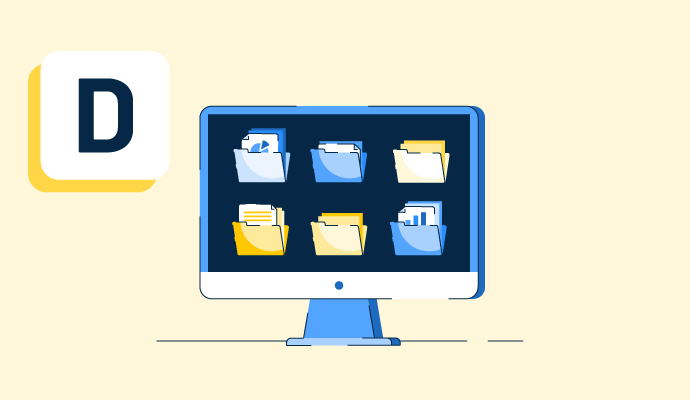What is document management?
Document management is the process of capturing, tracking, and storing electronic documents, such as word documents, PDFs, presentations, invoices, scanned images of paper documents, and other business documents.
Document management systems save a business time and money by providing centralized storage, access control and permissions, document security, audit trails, and streamlined workflows.
Some businesses use document management software to save, retrieve, and organize documents while allowing stakeholders to easily access them. The software improves reviewing and approval workflows, increasing the efficiency of administration teams.
Standard document management systems include features like document storage, version access control, full-text search, and analytics. These features support workflows of enterprises, governmental and educational institutions, and other authorities working with massive volumes of paper-based or digital documents.
Types of document management
Business demands and requirements vary. Organizations choose a particular document management type based on them.
- Enterprise content management (ECM): Enterprise content management (ECM) systems facilitate the process of capturing, storing, and organizing unstructured content in a centralized repository. ECM often is an umbrella term that sits above more narrowly defined document management systems, because it refers to the storage of any and all kinds of business information—scanned paper documents, digital files, emails, presentations, spreadsheets, etc.
- Knowledge management: Knowledge management software supports an integrated approach to identifying, capturing, retrieving, and sharing information assets that have a strong focus on how to accomplish a task, how to handle a situation, how a process works, and how to get a job done. Offering employees the ability to access the right information at the right time allows for better decision making and efficiency.
- Cloud content management: Cloud content management is the process of storing various types of content in the cloud, making it possible for teams to access information from anywhere and enabling collaboration.
- Record management preserves data and allows stakeholders to retrieve them when needed. Law, medicine, and government organizations primarily employ record management systems.
- Workflow automation allows companies to automate repetitive tasks in the document management process, reducing errors while saving time.
- Document imaging converts paper documents into electronic files and data.
Benefits of document management
Document management improves overall efficiency and security for organizations processing large volumes of data. Below are some benefits document management unveils for organizations.
- Time saving: Document management drastically improves document retrieval speeds, given the enormous amount of content circulating in a business. The metadata, tagging, and search features in document management systems allow for easy and accurate retrieval.
- Security: Document management systems allow administrators to set access and permission rules for more secure sharing of business documents.
- Space and resource reduction: Digitizing paper documents and storing them in these systems reduces the cost of paper, printing, and storage.
- Single source of truth: Content is constantly being replicated and edited, making it hard to keep track of the latest and most accurate information. Document management systems provide a full version history, so users know they are accessing the most up-to-date content.
- Workflow improvements: Some solutions are equipped with data extraction and analysis functionality, allowing for information to automatically flow into other business processes, thus optimizing the use of stored information.
- Increased collaboration: Document management breaks content out of its silos and shares it across a business, allowing users to view, edit, comment on, and annotate the same content.
Document management workflow
Document management workflow can be different for companies as they manage diverse records.

Below is a standard workflow to manage documents that teams can use as a baseline to create their own.
- Create a document: The document creation process involves understanding its goals, objectives, procedures, roles, and responsibilities. One may need to collaborate with writers or designers at this stage.
- Evaluate and approve the document: For this stage, the team sends the document to their managers, who check its content and give approvals.
- Upload the document: The team uploads the record with as many tags as possible to a document management system.
- Share the document: Once uploaded to the DMS, internal stakeholders get a notification to review. The team performs all reviews before publishing the document.
Basic elements of document management
Document management systems provide multiple functionalities, each with its own set of benefits for organizations. With the abundance of such functions, organizations need help deciding on the must-have and nice-to-have features. Here are a few general elements that are fundamental to effective document management practices:
- Document capture: Document management begins with scanning paper documents or importing digital files into the central repository. OCR software is often utilized to analyze and automatically organize captured documents.
- Storage: Businesses often have an overwhelming amount of data and content, so adequate storage space and storage capabilities are essential for document management.
- Search options help users locate files through a broad range of search capabilities, such as searching by keywords, last modified date, and file type.
- Workflow: Along with simply storing documents, document management systems often have the ability to automate the routing of documents to various people and processes, eliminating bottlenecks and streamlining business workflows.
- Distribution: Document management helps to get the right information to the right people. Effective systems will regulate the sharing and distribution of documents and folders of documents to authorized people.
- Accessibility controls allow only authorized users to easily access files. Access controls can be set based on a person, project, job role, and any criteria relevant to your organization.
- Integrations enable administrates to connect document management systems with other business software like customer relationship management (CRM) and email clients.
- Mobile-friendliness allows employees to store and retrieve files remotely or on the go.
Document management use cases
Companies adopt document management for various purposes. Below are some of the use cases of document management in organizations.
- Product manuals: Every company provides a guidebook for the services or products it offers. They come in different forms and sizes. These guidebooks aim to educate internal and external users about the product.
- Guidelines: Project management best practices include branding guidelines, compliance requirements, and design standards. Most projects' first phase involves establishing guidelines and identifying a point of agreement. Document collaboration tools help in creating policies.
- Personnel records: Security requirements vary depending on the document. Employee records are private and should only be accessible to approved members of top management and the HR team. An effective document management system uses access control to ensure that only authorized users can see confidential information.
- Protocols: A protocol is a group of actions or behaviors an organization uses to carry out a specific activity. For example, to manage a marketing project, one must define goals and objectives and the policies and procedures required to achieve them.
- Legal documents: Every legal record should be traceable. For example, a contract that has not been referenced for several years still needs to be preserved for use when there is a conflict between the parties who signed it.
Document management best practices
Adopting the following best practices allows businesses to implement effective document management practices:
- Clear and consistent folder and document naming structures: Consistent naming helps users find what they are looking for and reduces duplicate documents, reducing time spent on searching for files and overall confusion and frustration.
- Rules for version control: The purpose of document management is to organize content in a way that reduces clutter and gets the right content to the right people. Having set rules for when a new version of a document should and should not be created helps to keep the system organized and effective.
- Set up workflow automation: Prioritizing which processes to automate should depend on which processes are business-critical and most align with business objectives. The next step is to set up automation rules and inform users of these workflows.
Document management vs. content management vs. records management
Document management manages structured data, such as word documents, PDFs, presentations, etc., for primarily compliance and workflow management purposes. It tracks and manages digital documents and scanned images of paper documents. It generalizes a document creation process and automates approval and quality assurance, improving the overall efficiency of departments with massive volumes of documents.
Content management, using content management software, handles both structured and unstructured data, such as web content (HTML and PDF files) and digital files for the primary purpose of storage, retrieval, and publishing of web content.
Records management typically deals with documents that are evidence of a transaction or a decision. It imposes legal obligations on an organization. Insurance claims or a legal contract can be classified as a record.
Learn more about records management and understand how it contributes to an organization’s success.

Priya Patel
Priya is a Senior Research Analyst at G2 focusing on content management and design software. Priya leverages her background in market research to build subject matter expertise in the software space. Before moving back to Chicago in 2018, Priya lived in New Zealand for several years, where she studied at the University of Auckland and worked in consulting. In her free time, Priya enjoys being creative, whether it’s painting, cooking, or dancing.




















